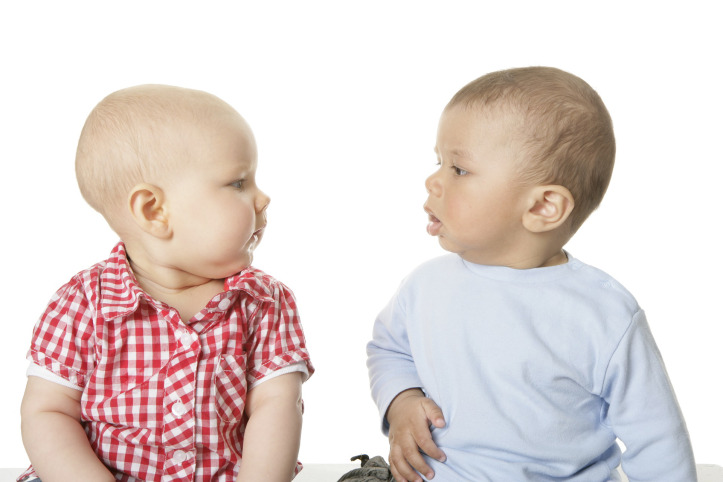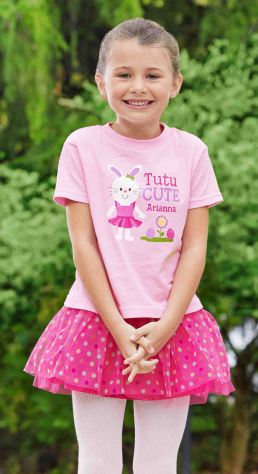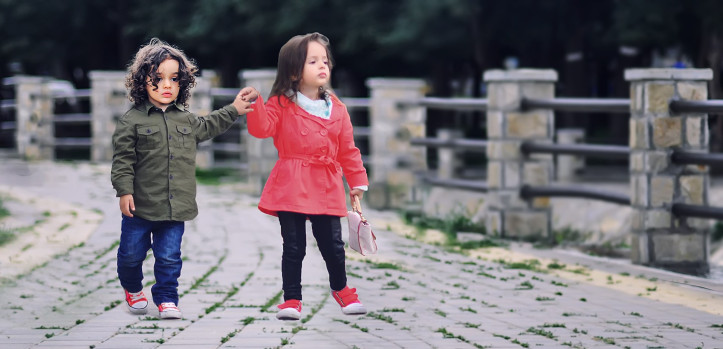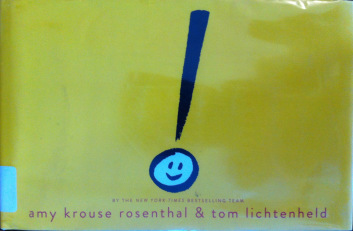By Pauline Agustoni
You are what you wear, or rather you become what you wear. Despite the wish of certain companies to promote gender neutral clothing for children, differences between boys and girls clothes still persist. The determined ideas that garments communicate about what being male or female means are dangerously limiting for the children and encourage them to follow a path marked by a long history of gender stereotypes.

Pink is for girls, blue is for boys
We all know the adage «pink is for girls, blue is for boys» that illustrates a strongly anchored attitude that has been dividing children per gender since the 1940s. Conceding that the color choice between girls and boys items in a clothing shop is the most obvious difference, it definitely isn’t the only one.
The fact that we don’t notice the other differences on a daily basis doesn’t mean they are harmless. On the contrary, our mind-set constantly changes according to our environment, what we hear, see and wear. As clothes are so closely related to the expression of somebody’s identity, the stereotypes they can carry out have a strongly restricting effect on children’s future opportunities, be they male or female.
Defining abilities through words
 Tutu cute
Tutu cute
Beside the color difference in clothing, the words written on the garments are obvious elements that deliver preconceptions concerning what a little boy or a little girl should be. The messages written on boys and girls t-shirts are so clear and biased they become creepy. If girls can expect to read «keep on smiling» on their favorite t-shirt, «cool, smart, genius, amazing and free» are common adjectives found on garments for little boys. These words encourage boys’ active behavior towards the world and strongly clash with adjectives for girls such as «cute, sweet, adorable, perfect», which enhance the importance of a girl’s looks over her actions.
With slogans such as «simply adorable», girls are not encouraged to have their own original personality but rather to be kind and cute and adopt a passive attitude. It relates to the sexist idea that girls should be discreet, helpful as well as empathic and evaluate other people’s well-being as being more important than their own. Boys on the other hand are assumed to be more self-centred and independent beings, with messages such as «veggies, no thanks» reminding them to be rebellious or «let’s go!» encouraging them to be active.
Such gender biased messages on clothes mark a deep separation between boys and girls by dividing their characteristics and abilities into two very distinct groups. These harmful messages closely relate to limiting stereotypes, which will determine what male and female children think they are capable of achieving in the future and what their roles within society need to be. If very young children can’t read themselves what is written on their t-shirts, the adults around them will still comment on the words and repeat them to the kids.
Why a bear will look so different on a boy’s shirt from on a girls’
 Rugby
Rugby
If words communicate behaviors, the motifs depicted on the garments play their role in defining the interests of the children wearing it. Cars, planes, rockets, headphones are usually reserved for boys and suggest a natural interest in complex mechanical objects. On the other hand, objects related to the household and sociability such as lipsticks, cups of coffee or tea, flowers or cell phones are the girls’ share. Even animals, which seem to be an unbiased type of motif, have their own set of stereotypes to communicate.
Most of the animals depicted on girls t-shirts are pets. Cute representations of smiling cats, panting dogs (never barking) or chubby bunnies are very common and if a polar bear made its way into the girls’ section, it is to appear in a cute version, with fluffy fur and eventually a pink ribbon on its head. Wild animals are depicted in a domesticated, friendly version. This sympathy for domesticated animals decorating girls t-shirts is an example of emphasizing girls’ supposedly stronger ability than boys to adopt a sociable and caring behavior and to invest in the private sphere of the household.
It’s a whole different story for the animals that appear in the boys’ section. On their t-shirts, fierce eagles fly in the air, huge bears roar and athletic tigers hunt. The represented dangerous animals live outdoors in wild environments, fitting the image of what boys should be interested in. This praises aggressiveness as a positive behavior of boys, as a way of facilitating their good start in the wild outdoor world. Displaying bold behaviors is promoted as a tool for boys to show their bravery, their autonomy. The attitudes expected of boys are limited too: if they don’t do so, they might be described as sissies and perhaps even be bullied.
The way the motifs are drawn also exhibit noticeable differences: the depicted girls animals are generally drawn in a cute rounded version, not respecting the scientific representation of the specimens, while the boys animals are drawn in their correct proportions, in a more realistic way.
When your jumper asks to be touchedMaterial is probably the least noticeable field that promotes gender differences, although it does, on an unconscious level. In the girls’ section, itchy tulle, sequins and glitter fabrics are common ground, communicating the idea that it is of bigger importance for girls’ clothes to be pretty than comfortable or functional. Their dresses, skirts and shorts are short and their pants tight. Once again, it enhances the importance of girls’ looks over their actions and presents them as sexually attractive beings who dress accordingly. Moreover, girls’ clothes are just unpractical to play with. Is the message that girls shouldn’t play outside and discover the world with their fellow male peers, running the risk of staining their pretty dresses?
Another shocking material use is the one made of fluffy fabrics. If they are to be found in the boys’ section, the soft and fuzzy part of the garment will be on the inside, to make a jumper warmer for example. However, the fluffy fabrics are commonly used on the outside of the garments of their female peers, providing not only a pleasant feeling of soft fabric to the girl wearing the jumper, but also to anyone who is likely to touch her. Not only this communicates the idea that a girl should be pleasant to see and touch, but on top of that it completely directs the way outsiders will interact with little girls. If it looks fluffy and soft, it asks to be touched, and this is the effect the garment will have. From a very young age on, girls will be used to be more caressed than their male peers are and both could be encouraged to consider this a normal thing.
The message that comes across through the clothes they wear is saying to little girls to be kind and passive and gets them used to be touched and caressed from a young age on. It isn’t so far-fetched to recognize that seemingly innocent design choices might have harmful impacts on much more severe issues, such as the paralysis that girls who are victim of physical abuse can adopt and the shameful feelings towards their perpetrators and themselves they might feel as a result. If these behaviors have a ground to develop from, it is the one that is transmitted to young children, via clothes amongst other, and the messages they communicate: literally saying that little girls should be nice, obedient and passive.
 Clothes as carriers of limitations
Clothes as carriers of limitations
«But little girls ask for all pink and glittery stuff!» is a comment I anticipate to hear. However, it is good to think about why they might even love it at first. Isn’t what you consider as a biological choice rather what our society (together with the fashion industry) thinks a girl should be?
The act of buying a pink t-shirt decorated with hearts and sequins for your niece is not a bad act in itself. But think about all the t-shirts she will receive during her childhood (and later on when she grows up) and about what will happen if all of them display examples of stereotyped ideas we talked about earlier in the article.
It is very clear and it will be the case for all children, girls and boys alike: it can limit their opportunities and restrict their field of action. It will have an impact on their self-awareness, their curiosity, their activities, their relations to others. People will talk to them differently, will touch them differently, will rate them differently.
Not only won’t these stereotypes challenge any of the inequalities that exist between gender and gender roles, but they also prevent any new non-binary vision about gender to be implemented. You will remain either an adventurous little boy or a sweet little girl.
References Maglaty J. (2011), When Did Girls Start Wearing Pink? Fine C. (2010), Delusions of Gender : How our Minds, Society and Neurosexism Create Difference Hale A.D. (2009), The Effects of Race, Gender and Clothing Style on Stereotype Activation Williams A. (2015), Everybody in dresses: Why does gender neutral clothing always mean «boy» clothes for girls? Haglund J.D. (2017), Did You Ever Notice This About The Clothes You Grew Up Wearing?Pauline Agustoni is a swiss Bachelor student at Design Academy Eindhoven. Fascinated by questions related to gender equality and feminism, she has been involved in artistic and research projects concerning the topic. Currently, in the context of the Textile Minor program, she and her teammates are developing a project aiming to challenge the existing gender stereotypes in children’s clothing.
Delen:






